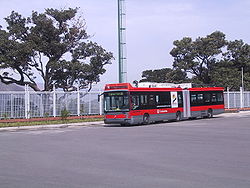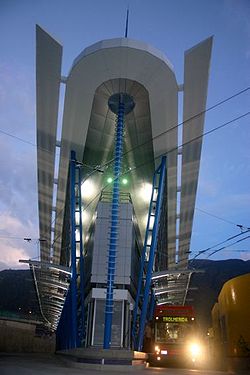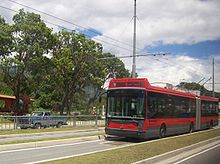- Trolleybuses in Mérida
-
Mérida Trolleybus System Info Locale Mérida, Venezuela Transit type Trolleybus Number of stations 15 Operation Began operation June 18, 2007 Operator(s) Tromerca (Trolebús Mérida, CA) Technical The Mérida trolleybus system is an electrified bus rapid transit system that serves Mérida, Venezuela, and surrounding communities. The current line, operated by dual-mode trolleybuses, is considered to be "Line 1" of a planned three-route "Mass Transport System" (Sistema de Transporte Masivo), of which Line 2 is also to be trolleybus and Line 3 is to be an aerial cableway. Line 3 was originally planned as a funicular, but was changed to a cableway in 2005.[1] Construction of line 3, the cableway (now named Trolcable), was about 50 percent complete as of May 2011.[2] Construction has yet to begin on Line 2. The operator of the system was originally named Trolmérida, but in September 2009 its name was changed to Tromerca, for Trolebús Mérida, C.A.[3]
Contents
The route
A trolleybus at the impressive Terminal Ejido station, designed by Venezuelan architect Roberto Ameneiro[1]
Only a little more than half of Line 1 has opened, thus far. If completed as planned, the full Line 1 will be 18.2 km in length and have 34 stations.
The first 10.2-km section, serving 15 stations, was inaugurated on June 18, 2007. The route connects Ejido with Mérida. Service currently ends at Pie del Llano station, south of Mérida city center. Construction continues, somewhat sporadically, on the section of the line extending northeastwards from there, into the city center.
The following stations are in full operation:
- Terminal Ejido
- Pozo Hondo
- Centenario
- Montalbán
- Las Cruces
- Pan de Azúcar
- La Parroquia (proposed Line 2 transfer point)
- La Mara
- Alto Chama
- Carrizal
- Museo de Ciencias
- Las Tapias
- El Acuario
- San Antonio
- Pie del Llano.
The following stations of Line 1 are under construction or planned:
- Santa Juana
- Soto Rosa
- María Mazzarello
- Campo de Oro
- Juan XXIII
- Luis Ghersy
- Medicina, facultad de
- Liceo Libertador
- Simón Bolívar (transfer stop to future Line 2)
- Obispo Lora (transfer stop to future Line 2)
- Las Américas
- Sor Juana Inés
- Plaza de Toros
- Albarregas
- Santa Ana
- Domingo Salazar
- Fundacite
- Los Chorros
- Núcleo La Hechicera
Operation
The route is served by a fleet of 45 articulated trolleybuses supplied in 2003 by a partnership of Hispano Carrocera and Mercedes-Benz of Spain, with the vehicles' electrical propulsion equipment provided by Bombardier. Ordered in December 1998, all 45 were delivered in 2003, but construction of the line had fallen behind schedule by then, so the vehicles were stored for an extended period, until the first section of the route was completed.[4]
Like other BRT systems, the vehicles operate in their own exclusive lanes over the route's entire length, to avoid delays from traffic congestion and reduce travel times. Boarding takes place at fully enclosed, high-platform stations, permitting quick boarding and alighting of passengers. Similar to many modern light rail and metro systems, the platforms are vertically aligned with the vehicles' floors, and the vehicles have no steps at their doorways. The only previous trolleybus system to use such a system of level boarding at high platforms is El Trole in Quito, Ecuador, and the Mérida system was said to be modeled on the Quito system, which has been very successful. Fare collection will take place within the stations, before boarding, so that loading can take place via all three vehicle doorways simultaneously. However, as the line is still in its first phase, and has not yet reached the city center, the start of fare collection has been delayed, and all rides are free at present.
Future routes
Line 2, the second trolleybus route, is only in the planning stages and is expected to be 12 km long with 3 common stations alongside or crossing Line 1. It would connect La Parroquia with La Vuelta de Lola. Line 3, the aerial cableway (currently under construction), will connect San Jacinto, in the Chama River valley below the city, to a Line 1 trolleybus station in central Mérida and is about 1 km long.
See also
References
- ^ a b Morrison, Allen. The Trolleybuses of Mérida, Venezuela. Retrieved 2009-3-24.
- ^ "Avanza construcción de estaciones del Trolcable de Mérida" (in Spanish). El Nacional. 19 May 2011. http://www.elnacional.com.ve/www/site/p_contenido.php?q=nodo/208421/Regiones/Avanza-construcción-de-estaciones-del-Trolcable-de-Mérida-. Retrieved 31 August 2011.
- ^ Trolleybus Magazine (UK) No. 289 (January-February 2010), p. 23. ISSN 0266-7452.
- ^ Trolleybus Magazine (UK) No. 259 (January-February 2005), p. 24.
External links
Categories:- Trolleybus systems by city
- Trolleybus transport
- Bus rapid transit
- Rapid transit in Venezuela
Wikimedia Foundation. 2010.




